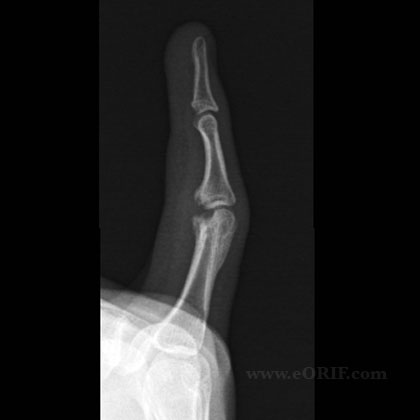 |
synonyms:
Phalangeal Neck Fracture ICD-10
A- initial encounter for closed fracture
B- initial encounter for open fracture
D- subsequent encounter for fracture with routine healing
G- subsequent encounter for fracture with delayed healing
K- subsequent encounter for fracture with nonunion
P- subsequent encounter for fracture with malunion
S- sequela
Phalangeal Neck Fracture ICD-9
- unspecified = 816.00 (closed), 816.10(open)
- proximal or middle phalanx = 816.01(closed), 816.11(open)
- distal phalanx = 816.02(closed), 816.12(open)
- multiple sites = 816.03(closed), 816.13(open)
Phalangeal Neck Fracture Etiology / Epidemiolgy / Natural History
Phalangeal Neck Fracture Anatomy
- usually distal fragment displaces into extension. Proximal metaphyseal fragment occludes the volar subchondral fossa and blocks IP flexion.
- Collateral ligaments preserve blood supply to distal fragment. If open reduction is needed, ensure collateral ligaments are preserved. (Yousif NJ, J Hand Surg Am 1985;10:852-861)
Phalangeal Neck Fracture Clinical Evaluation
- evaluate finger cascade with flexion. Any overlaps of injured digits indicates need for reduction +/- fixation.
Phalangeal Neck Fracture Xray
- P/A and lateral views of affected finger
- 30-45 degree suppinated or pronated views
Phalangeal Neck Fracture Classification / Treatment
Phalangeal Neck Fracture CRPP Technique
- Belsky MR, J Hand Surg 1984;9Am:725(link is external)
- 0.045 (1.1mm) K-wires generally used. Consider 0.062in(1.6mm) for larger bones(metacarpal); 0.035in(0.9mm) for smaller bones (pediatric fx).
- Closed reduction under c-arm guidance.
- one or more intramedullary or two crossed K-wires.
- K-wires must not cross at the fracture site.
- K-wires are left in until fracture callus in visible on xray. Usually 3-4 weeks
Phalangeal Neck Fracture Associated Injuries / Differential Diagnosis
- Phalangeal Base Fracture
- Phalangeal Neck Fracture
- Distal Phalanx Fracture
Phalangeal Neck Fracture Complications
- Flexion Contracture: see Hogan CJ, JAAOS 2006;14:524.
- loss of reduction
- delayed union
- malunion: if radiolucency is still evident, attempt percutaneous pin osteoclasis with CRPP. Avoid central extensor mechanism. Pin may be used to lever fx volarly to restore subchondral fossa. (Bernstein SM, J Pediatr Orthop 1993:13;85-88) If fully healed consider osteotomy (Simmons BP, J Hand Surg Am 1987;12:1079-1082) or remodeling in pediatric pts (Hennirkus WL, JBJS Br 2003;85:273-274)
- tendon adhesion / stiffness
- nerve or vascular injury
Phalangeal Neck Fracture Follow-up
Phalangeal Neck Fracture Review References
- Freeland AE, Geissler WB, Weiss AP, Operative Treatment of Common Displaced and Unstable Fractures of the Hand, JBJS 2001;83A:928-945
- Freeland AE, Orbay JL. ORIF of the Tubular Bones of the Hand In: Stickland JW, Grahma TJ, editor. Hand 2nd ed. Master Techniques in orthopedic surgery. Philadeplhia: Lippincott-Raven; 2004. p 3
|

